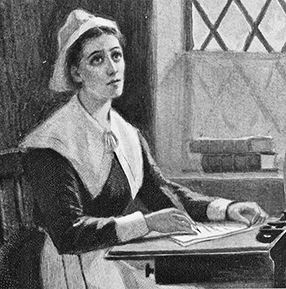Winter
Cold, moist, young phlegmy winter now doth lie
In swaddling clouts, like new-born infancy;
Bound up with frosts, and fur’d with hail & snows,
And, like an infant, still it taller grows.
December is my first, and now the sun
To the southward Tropick his swift race doth run.
This month he’s hous’d in horned Capricorn,
From thence he ’gins to length the shortened morn,
Through Christendom with great festivity,
Now’s held (but guessed) for blest Nativity.
Cold, frozen January next comes in,
Chilling the blood, and shrinking up the skin.
In Aquarius now keeps the long-wish’d sun,
And northward his unwearied course doth run.
The day much longer than it was before,
The cold not lessened, but augmented more.
Now toes and ears, and fingers often freeze,
And travelers their noses sometimes leese.
Moist snowy February is my last,
I care not how the winter-time doth haste.
In Pisces now the golden sun doth shine,
And northward still approaches to the line.
The rivers ’gin to ope, the snows to melt,
And some warm glances from his face are felt;
Which is increased by the lengthen’d day,
Until by’s heat, he drive all cold away.
And thus the year in circle runneth round;
Where first it did begin, in th’ end its found.
This poem is in the public domain. Published in Poem-a-Day on December 16, 2023, by the Academy of American Poets.
“Winter” appears in The Tenth Muse Lately Sprung up in America (Stephen Bowtell, 1650). The poem is the fourth and final section of a quaternion titled “The Four Seasons of the Year.” In “‘The posy UNITY’: Anne Bradstreet’s Search for Order,” published in Puritan Influences in American Literature (University of Illinois Press, 1978), Emily Stipes Watts, professor emerita at the University of Illinois Urbana–Champaign, writes, “[I]n the fourth Quaternion, ‘The Four Seasons,’ Childhood becomes part Winter and part Spring [. . .],” alluding to Bradstreet’s use of images like the swaddled infant to describe the cold weather. Watts adds, however, that “Old Age [becomes] part Autumn and part Winter. Somehow man himself does not ‘fit’ into the general scheme of things,” pointing out that the four sections of the quaternion overlap in their thematic material, creating an imperfect loop in its analogy with the stages of human life. As Samuel Fallon, associate professor of English at SUNY Geneseo, writes in “Lately Sprung up in America: Anne Bradstreet’s Untimely Worldmaking,” published in Journal for Early Modern Cultural Studies, vol. 18, no. 4 (Fall 2018), “‘The Four Seasons’ [. . .] offers a model of circular, redemptive time, with winter coming round to a new spring as the sun, at the end of the poem, ‘by’s heat [. . .] drives all cold away.’”

